I silently vowed never to complain about having to wait for water to boil ever again. Now when I’m back at home in my own kitchen I always think of how Loubna cooks like this to feed her family every day. It is an art form that is lost in the fast paced American lifestyle of the 9-5 career woman. I almost lost it myself once upon a time when I worked in the big fancy corporate world. Learning from Loubna helped me to get it back and it is something I will treasure forever.
I’ve lived in Morocco for over three years and have had many opportunities to sample the local cuisine. However, I have to admit that I’ve been a bit clueless about some of the ingredients I see around me here every time I go to the market. Food shopping here is very different than what I was used to in America, and I had to let go of a lot of pre-conceived ideas. Morocco is indeed a land of abundance. Yet there are some things that are really hard to find. While I do have my mom back in the States send me a care package from time to time, I know it would be better in the long run to learn what to do with the ingredients that are easily available to me here. Then one day I saw an advert for a cooking tour on a Facebook expat group and I jumped at the opportunity. I hope you’ll enjoy coming along with me as I share our experience in pictures.
Our excursion was led by our new friend Aidan who is starting up his own “foodie” cooking tours in Marrakech. My husband Tivon and I met up with Aidan at Jemaa El Fna, which is the famous center of the medina.
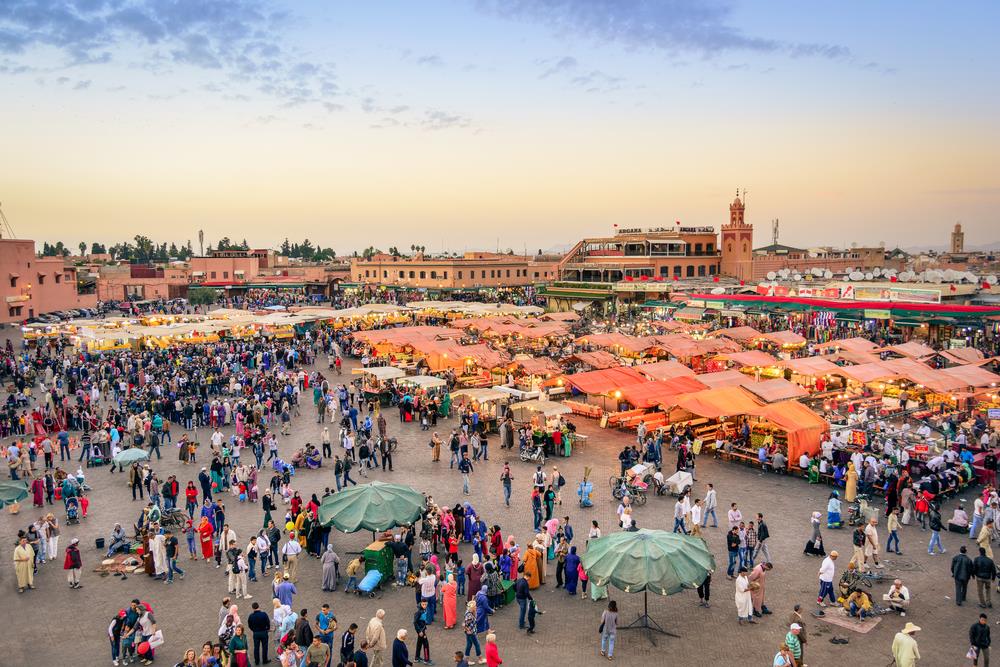
Jemaa El Fna in Marrakesh Medina
Our first order of business was to travel through the stalls and pick up the ingredients for our meal. This was so helpful as Aidan was explaining what all the ingredients were, where they come from, how they are made and how they are used.
First on the list was olives, preserved lemon and olive oil from the olive stand.
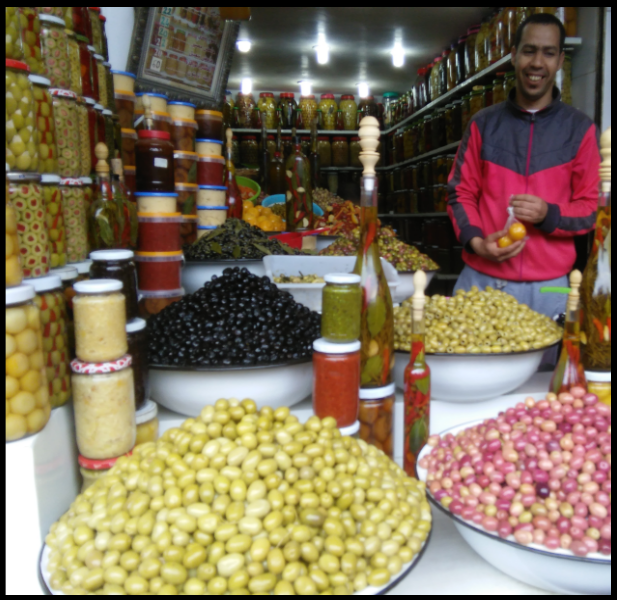
The olive stands in the medina
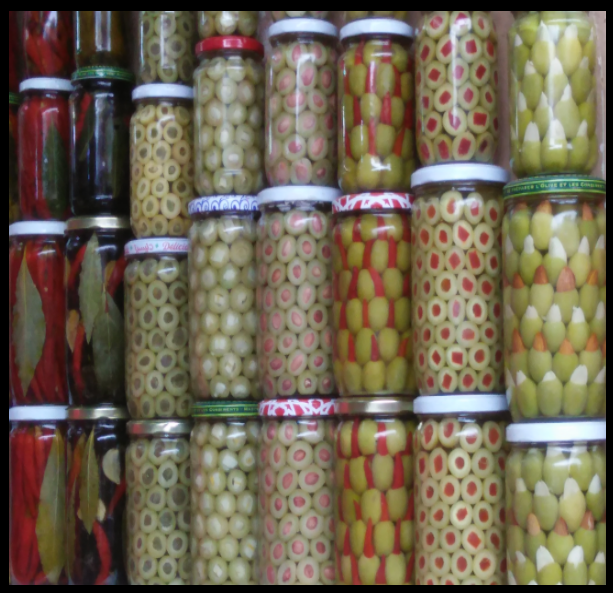
Preserved olives and peppers in the medina
I learned that there are two types of preserved lemons, one which is aged for 7-8 months and another aged for 18 months. Each has a very distinct flavor. I’ve fallen in love with pickled lemons since coming to Morocco. Its hard now to imagine life without them!
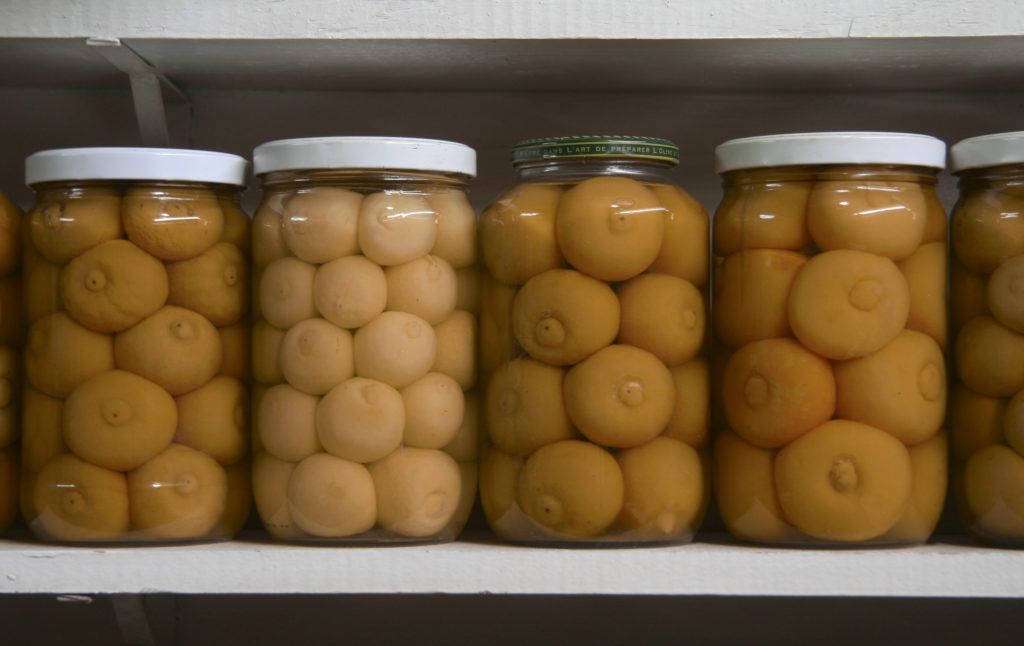
Moroccan pickled lemons
Next we were off to the spice market, where we got a full education about the many spices in Morocco. Most of them come from here, but there are many others that come from areas all over the African continent. The tastes and smells were incredible.
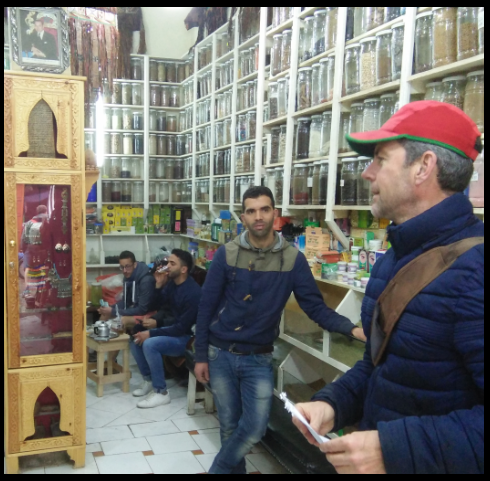
Aidan (far right) at the spice market Marrakesh.
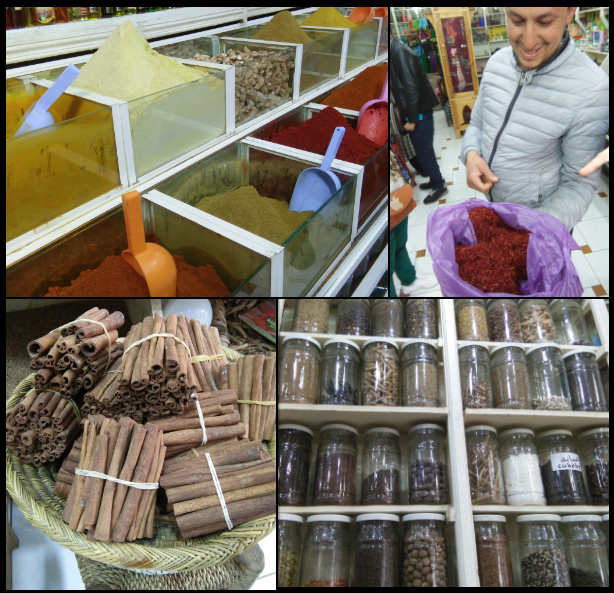
Spice Market Marrakesh. Bulk spices, fresh saffron, cinnamon and a variety of spices in jars.
I also learned about saffron. The real good stuff comes from the saffron flower and takes a lot of labor to harvest. This is why it can be expensive. Beware of the cheap stuff which is nothing more than dried corn husk fibers dyed to look like saffron. You can certainly tell the difference in the way it smells!
Next was a stop at the butchers where we bought meat for the beef tangia dish we were going to make as well as a half a small chicken for the chicken tagine. Normally you would buy the meat at the butcher and he would cook the tangia for you then you would come back later in the day to pick up your dish for dinner. But in our case, we were going to cook it ourselves.
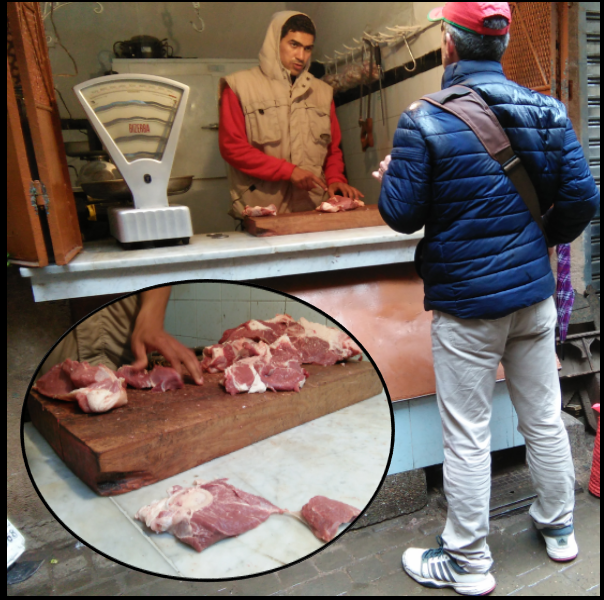
Aidan from Marrakesh Cooking tours buys meat from the Local Butcher Marrakesh Medina.
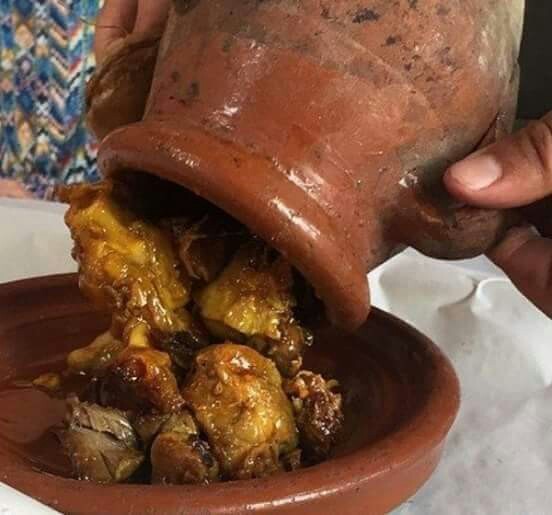
One of the dishes are going to prepare, beef tangia cooked in a clay pot on hot coals.
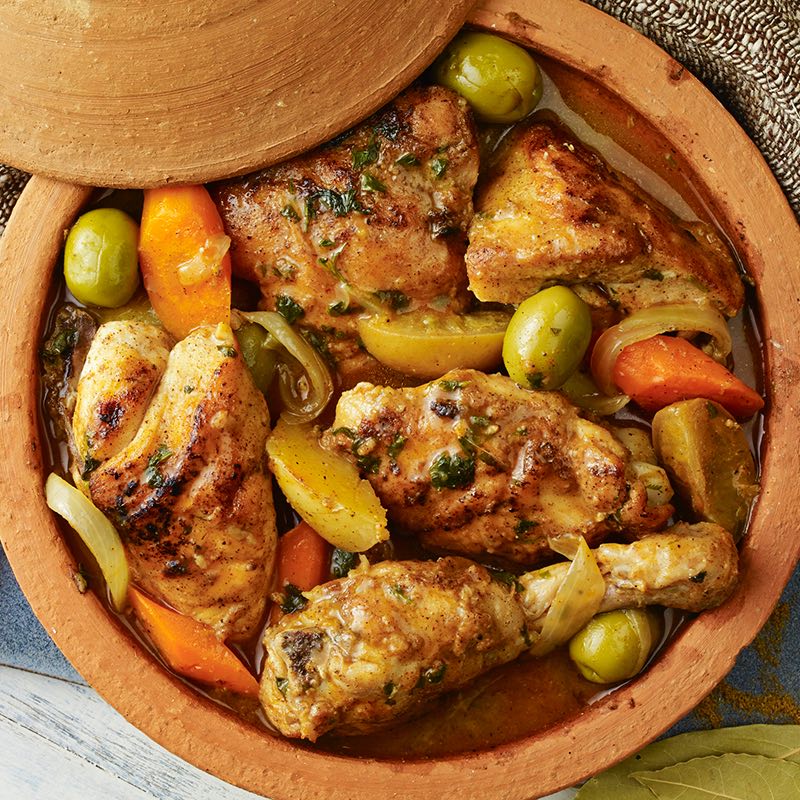
Another dish we are going to prepare, Chicken tagine made in a clay dish with a top cooked over a charcoal flame.
Then we were off to the vegetable stalls to buy fresh ingredients from the local farmers. We needed fresh lemons, new onions, tomatoes, parsley, celery leaf, eggplants, peppers, and soaked chic peas.
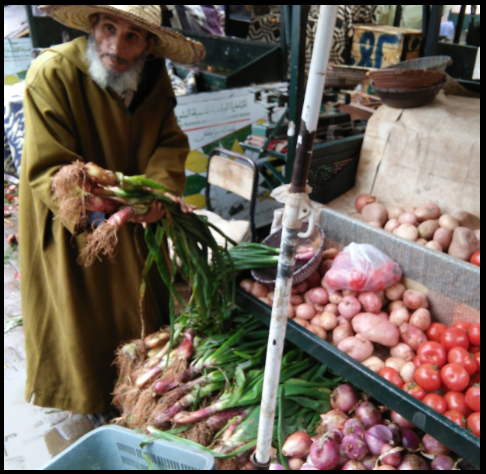
New spring onions from the farmers at the local produce stalls.
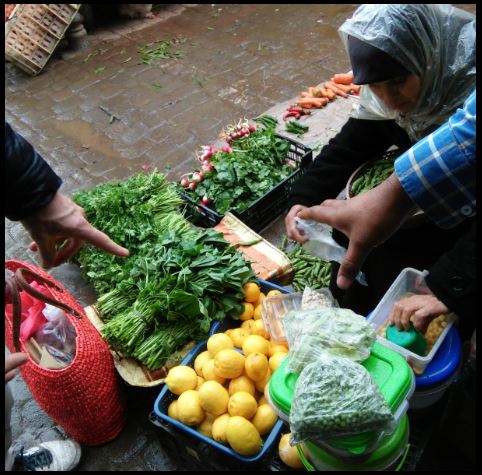
Fresh lemons, herbs and soaked chic peas at the local produce stalls.
The famous Moroccan soup harira is always served with dates, so we got a few of those and said hello to a cute donkey that was pulling the carts of wares through the streets. Also, we got some oranges for a simple orange and spice dessert.
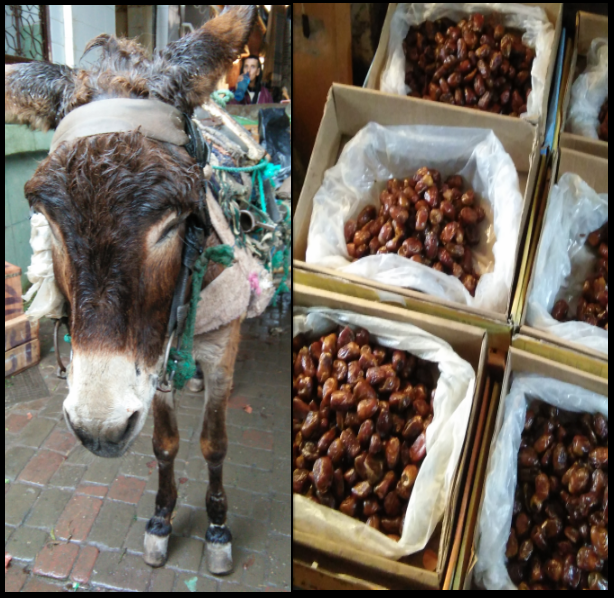
Donkeys and Dates in the Marrakesh medina.
Next, we walked through the medina carrying our goods to the lovely family home where we would be cooking.
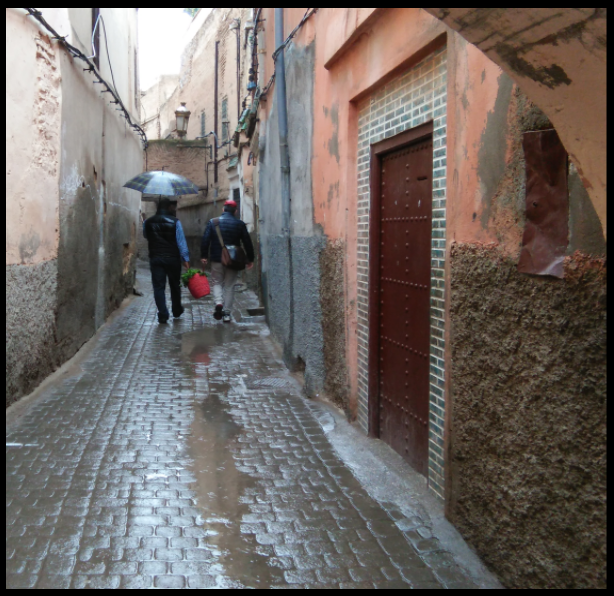
Bringing the ingredients to the Riad where we will cook dinner.
We were greeted at the door by the cook and wife Loubna. She lives here with her husband Marouane and mother Malika and their three small children. This was perhaps one of my favorite parts of the entire experience. I loved that we were in the real home of a real family learning how the people here live and prepare home cooked meals.
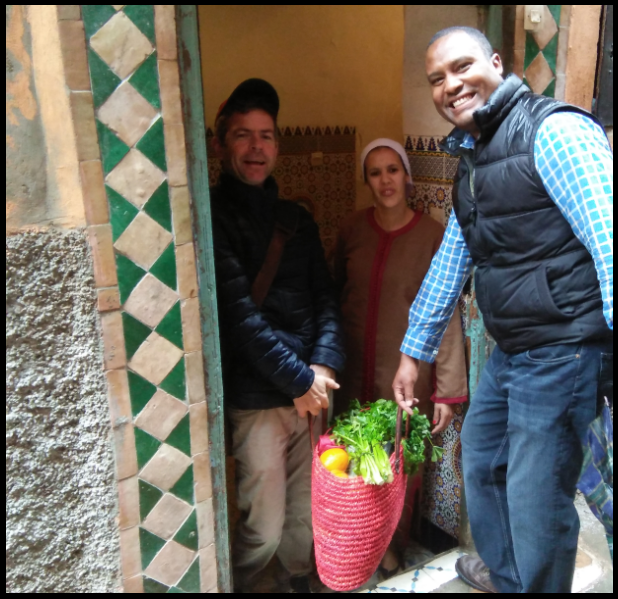
Loubna greets us at the door while Aidan and Tivon carry in the groceries.
I later asked Loubna if she cooked like this every day. “Of course!” was her answer. Suddenly years of convenience food I was accustomed to in America flashed into memory and I silently vowed never to complain about having to wait for water to boil ever again. Now when I’m back at home in my own kitchen I always think of how Loubna cooks like this to feed her family every day. It is an art form that is lost in the fast paced American lifestyle of the 9-5 career woman. I almost lost it myself once upon a time when I worked in the big fancy corporate world. Learning from Loubna helped me to get it back and it is something I will treasure forever.
It was raining outside, which is actually a rare thing in the dry climate of Marrakesh. Our first order of business was to warm up with some Moroccan mint tea.
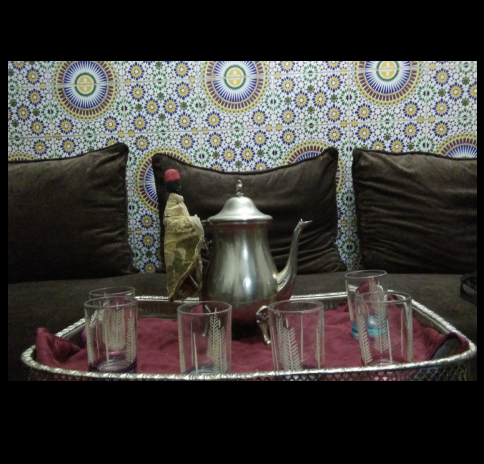
Moroccan mint tea to warm us up on a cold rainy day.
I got the full proper lesson on how to make tea. Moroccan’s are very proud of their tea, they call it “Moroccan whisky”. Each house has their own special way of making it. In this case you put tea and fresh mint leaves in a silver pot with boiling water and sugar and then you place this on the stovetop fire and wait for the leaves to rise up into a boil in the pot. Then it is done.
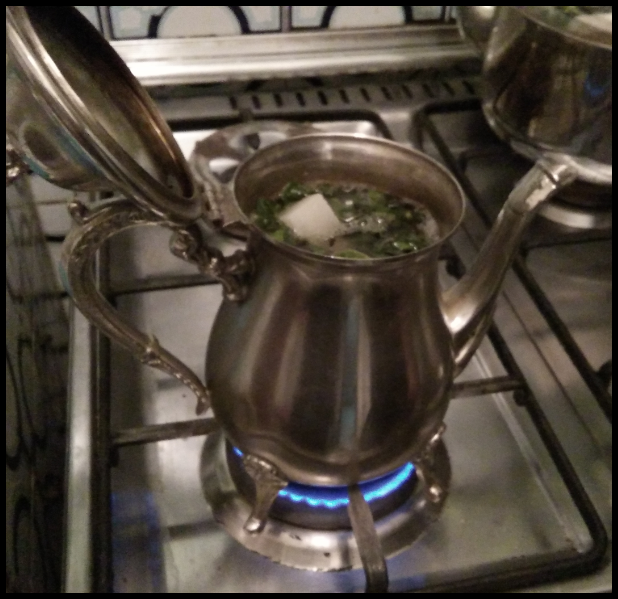
The proper way to make Moroccan mint tea.
Houses or “Riad’s” in the Medina are fit very close together, and right next door to the family’s home was a hammam. This is a local bath house where people go for hours of endless hot water for bathing.
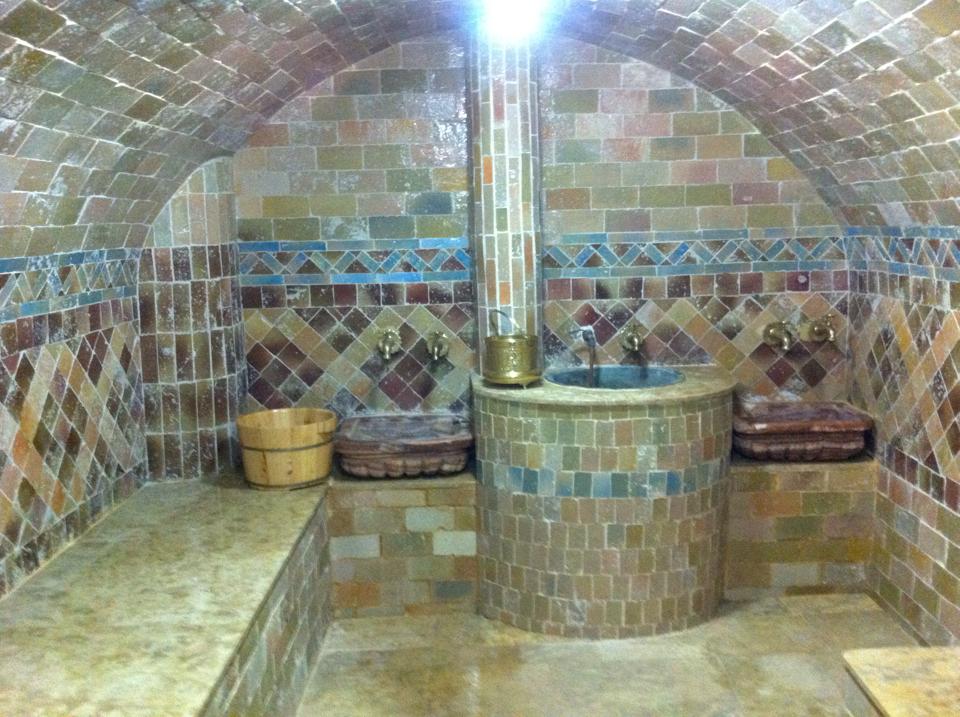
An example of a Moroccan hammam. I took this picture inside of another hammam up in the North of Morocco.
The hammams water is heated in a giant tank with a fire underneath it. This fire is started early in the morning and burns all day long. The coals from the fire serve as a place to cook meat in pots.
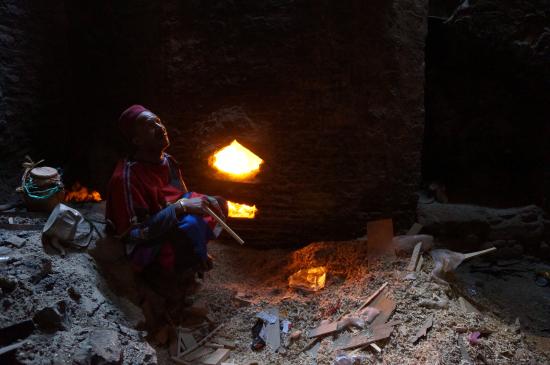
Hammam fire stoker
Beef Tangia is a main course that consists of meat and spices cooked inside of a covered clay pot for several hours in a bed of coals. First we mixed several of the Moroccan spices including saffron, garlic and pickled lemon (aged 18 months) into the meat and stuffed it all into the clay pot. A paper seal was placed on the top of the pot and wrapped on tight.
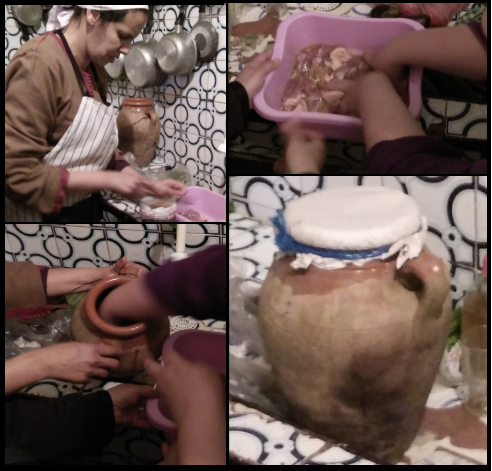
Making the beef tangia
Then we walked the pot down the alley way next door to set it in a pile of hot coals from the hammam fire. It would take about 3-4 hours to cook.
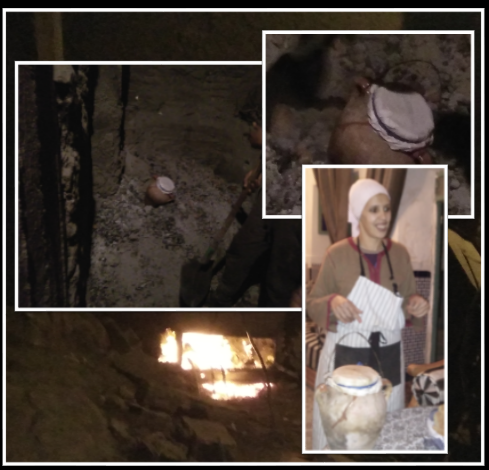
Cooking the beef tangia on a bed of hammam fire coals
The next course to prepare was the famous harira soup. This soup consists of vegetables, herbs and spices, with chick peas, lentils and rice in a tomato base. It is served during Ramadan to break the fast along with some dates on the side and a squeeze of fresh lemon on top. To help speed up the cooking time we placed most of the ingredients in a pressure cooker first. Later on we would add the tomato paste and flour base and salt to taste.
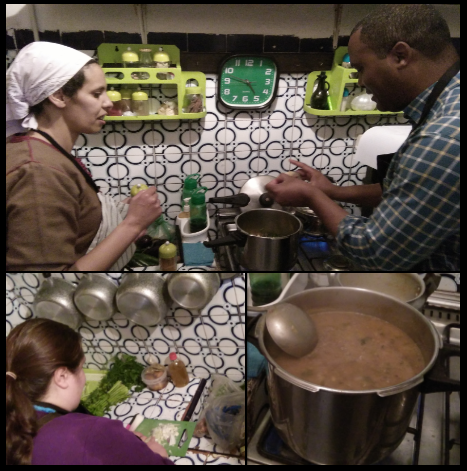
Making Harira soup
Also, the salt comes in a pure form. Aidan had a rock of salt that he crushed fresh to taste. So much better for you than table salt! The salt around here that we buy at our local souk market comes from ancient sea beds that are now near the tops of the atlas mountains. We use this salt on everything from fermenting foods, to taking salt baths. Its really amazing stuff!
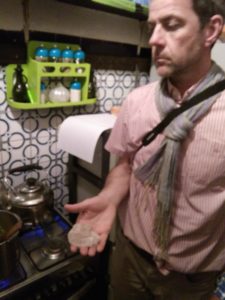
Aidan with a rock of pure salt
By this point the smells and the tasting of the ingredients were flowing through the riad and the place came to life with good food and family. The families three adorable children came home from school to hugs and kisses from their mom and dad. Grandma Malika got them set up with Moroccan breads and tea while they watched after school cartoons that looked like a Moroccan version of Mario Brothers. It reminded me of what I used to watch after school when I was kid.
Next we moved on to make the chicken tagine and vegetable side dishes. The chicken was dressed in spices, onions and pickled lemon and first cooked most of the way in a pressure cooker. Then the olives were then boiled in water and the whole thing was placed in a tagine clay dish with a cover over a charcoal fire to simmer.
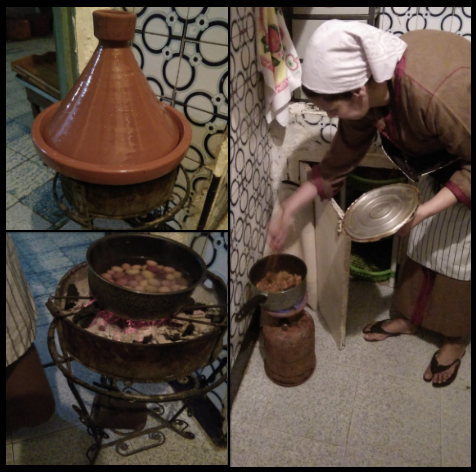
Making chicken tagine
The side dishes were two similar dishes using cooked Morocan vegetables. One salad was called zaalouk, which had eggplant in it and was similar to baba ganoush. The other was called chatchoukak which was made with green peppers and onions.
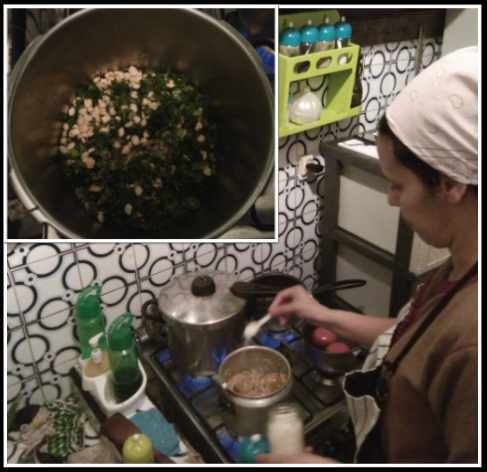
Making zaalouk and chatchoukak
With all the dishes simmering away, we took a short break and walked down to the near by Moroccan photography museum. It was such a lovely treat to see photos of the Moroccan culture from the past.
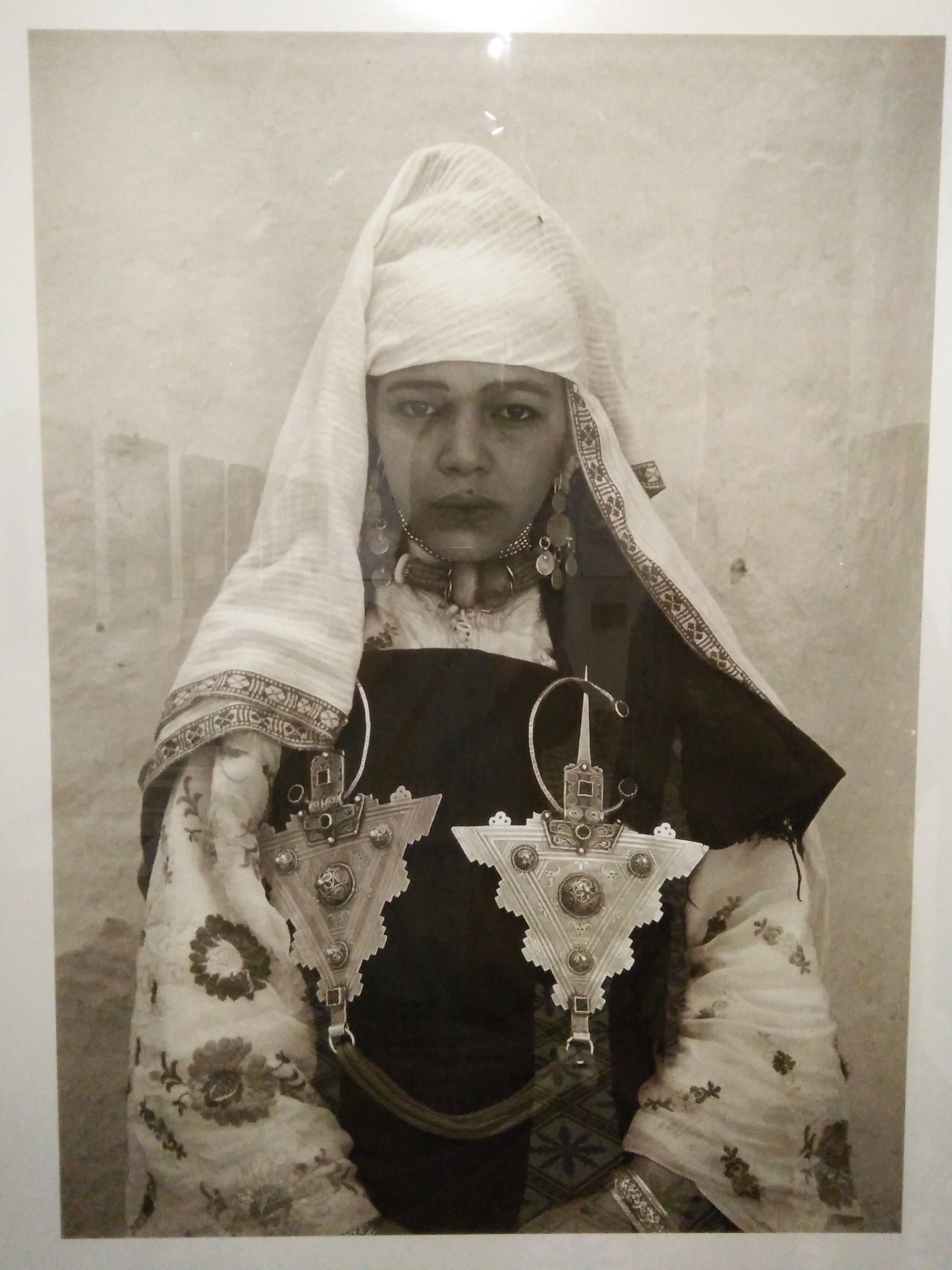
Old photo of a Berber girl in Morocco
Now it was time to eat! Loubna set a beautiful table for us in the main dining room of the riad. We started with the Harira soup with dates lemon and fresh baked bread.
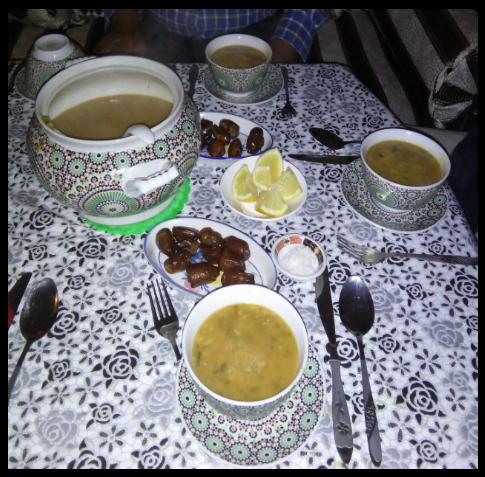
Harira soup with dates, lemon and fresh bread
This time around we did not make the bread ourselves, but I figured that this would be a great time to tell you about Moroccan bread making. In the medina there is a community oven that is stoked with a hot fire they start early in the morning. Each Moroccan family makes its own bread dough and walks the dough down to the community oven where the baker bakes the daily bread. I have memories of running into local women I knew when living up North here as they were coming home from the community oven with their family’s daily bread. They were always so kind to offer me a sample.
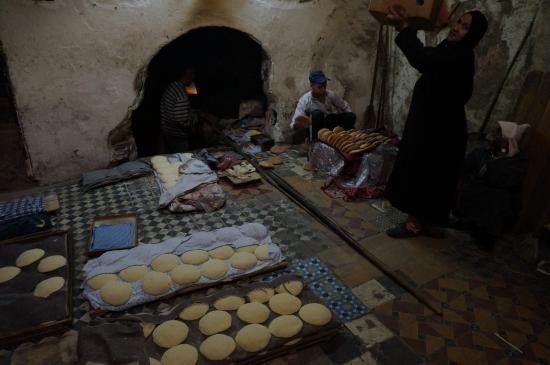
Moroccan communal oven for baking bread
Next up was the main courses of beef tangia and chicken tagine. I have to admit, that while I’ve had these dishes in local restaurants, they never tasted as good as the ones we made ourselves!
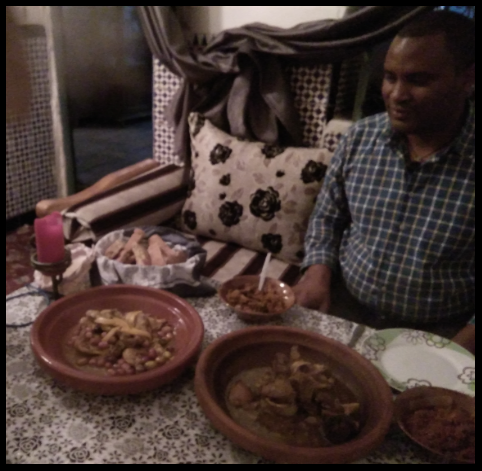
Main courses beef tangia and chicken tagine with zaalouk and chatchoukak side dishes.
Then we finished off our meal with a simple dessert of fresh sliced oranges with ground cinnamon and orange blossom flower water sprinkled on top.
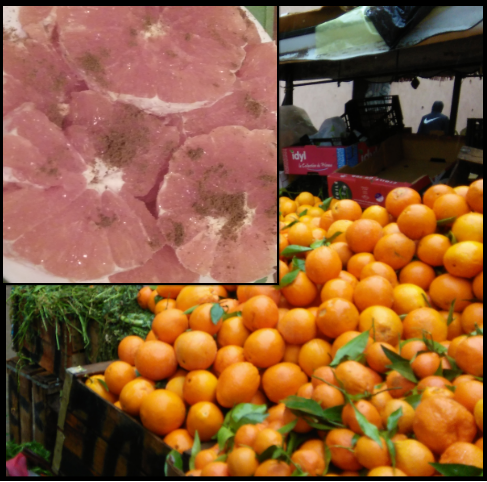
Dessert of sliced oranges with cinnamon and orange blossom flower water
It was an incredible experience and one that we will never forget. We loved meeting Aidan and the beautiful family that brought us into their home. If you are ever in Marrakesh be sure to book a cooking tour with Aidan. You can visit his Facebook page here to contact him here https://www.facebook.com/AidtheMaid/

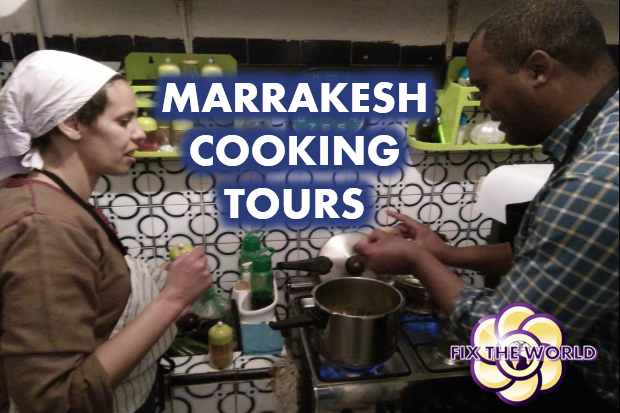

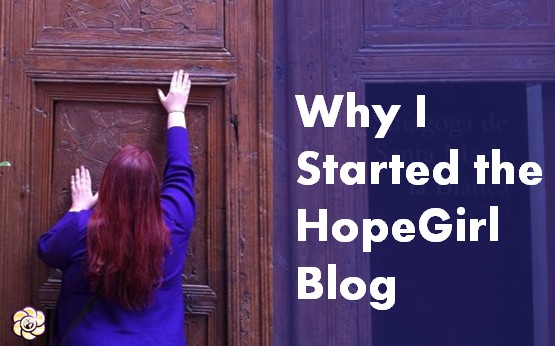






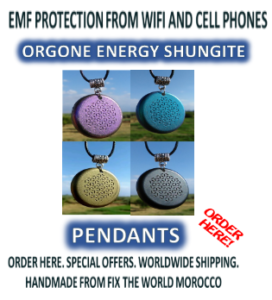
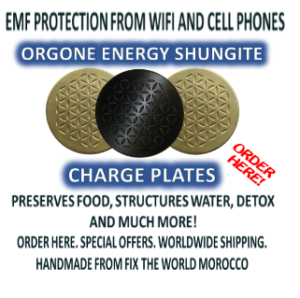


0 Comments